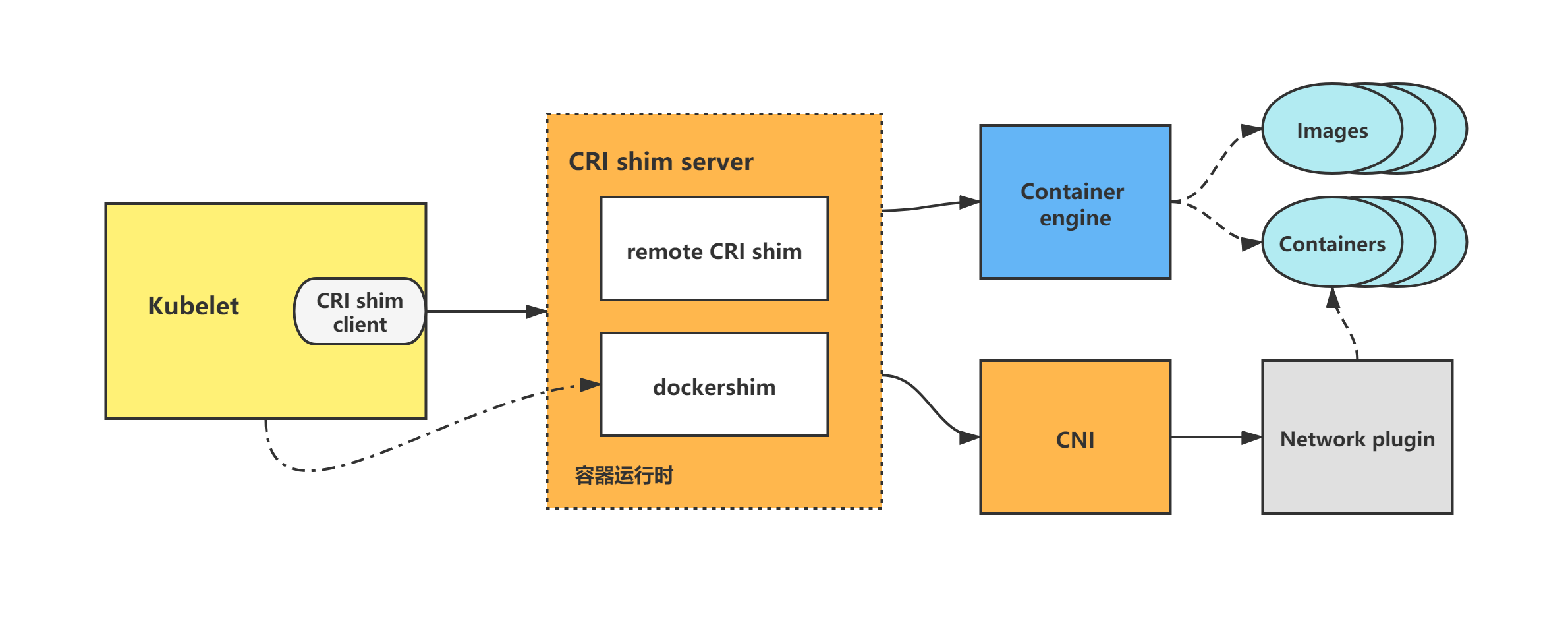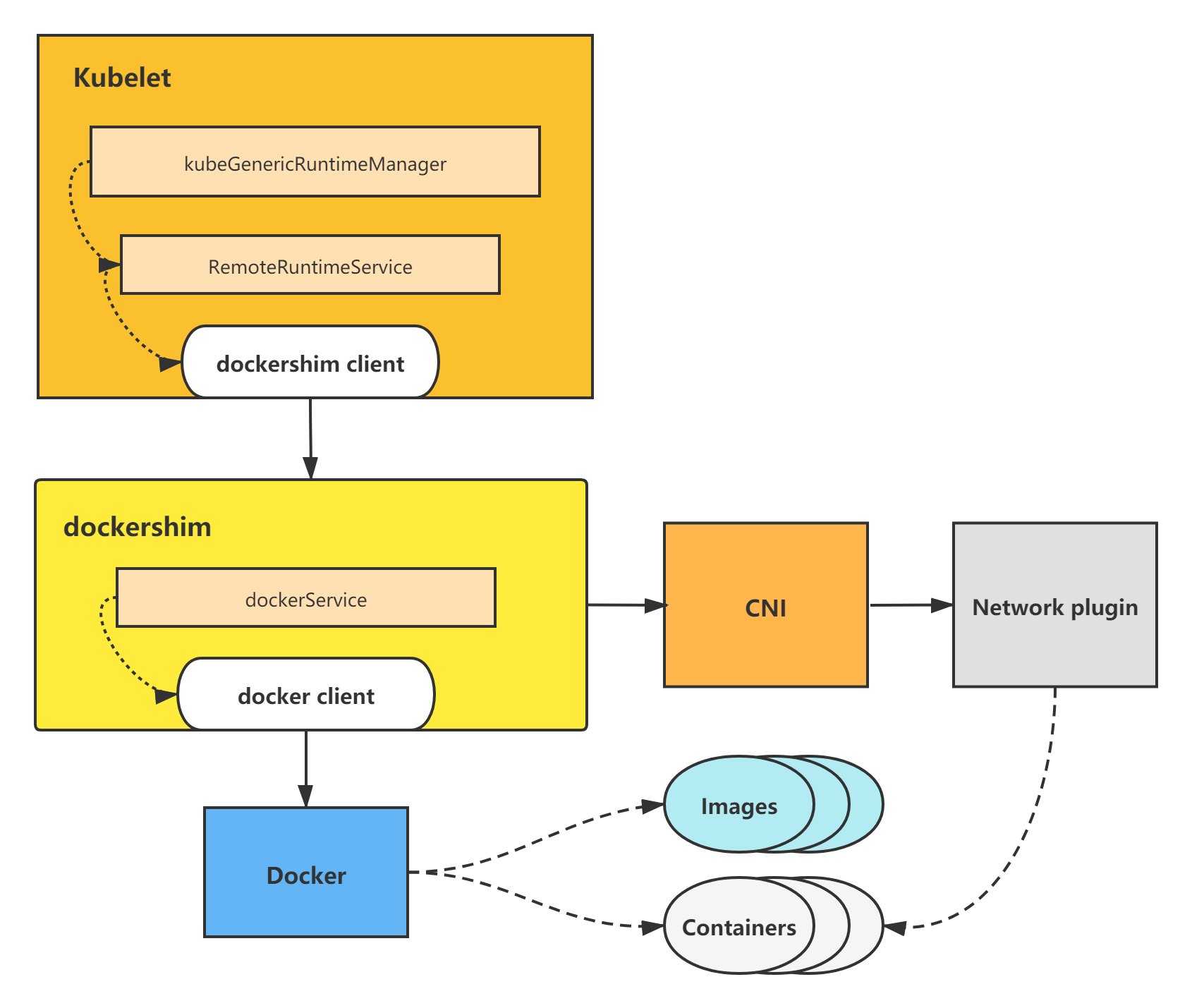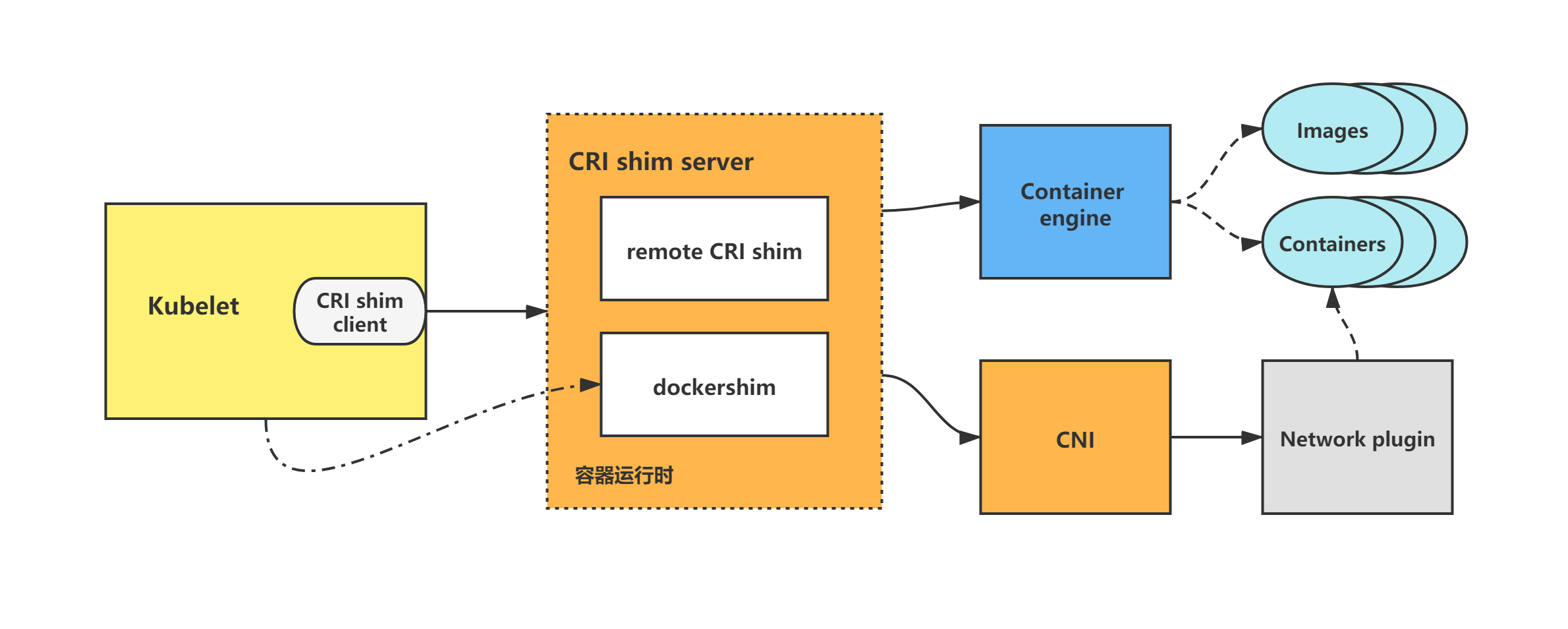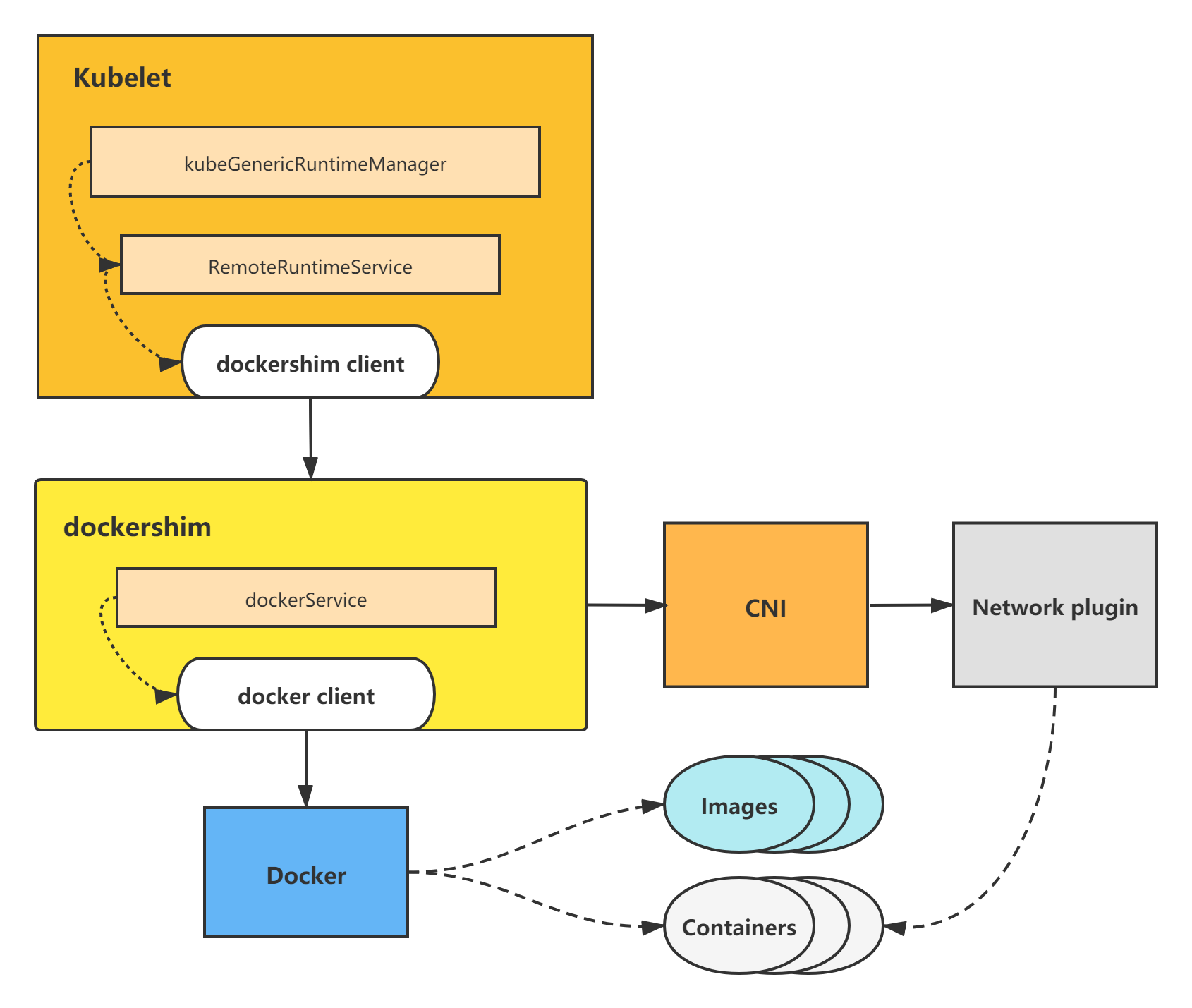kubernetes/k8s CRI分析-kubelet创建pod分析
先来简单回顾上一篇博客《kubernetes/k8s CRI 分析-容器运行时接口分析》的内容。
上篇博文先对 CRI 做了介绍,然后对 kubelet CRI 相关源码包括 kubelet 组件 CRI 相关启动参数分析、CRI 相关 interface/struct 分析、CRI 相关初始化分析 3 个部分进行了分析,没有看的小伙伴,可以点击上面的链接去看一下。
把上一篇博客分析到的CRI架构图再贴出来一遍。

本篇博文将对kubelet调用CRI创建pod做分析。
kubelet中CRI相关的源码分析
kubelet的CRI源码分析包括如下几部分:
(1)kubelet CRI相关启动参数分析;
(2)kubelet CRI相关interface/struct分析;
(3)kubelet CRI初始化分析;
(4)kubelet调用CRI创建pod分析;
(5)kubelet调用CRI删除pod分析。
上篇博文先对前三部分做了分析,本篇博文将对kubelet调用CRI创建pod做分析。
基于tag v1.17.4
https://github.com/kubernetes/kubernetes/releases/tag/v1.17.4
4.kubelet调用CRI创建pod分析
kubelet CRI创建pod调用流程
下面以kubelet dockershim创建pod调用流程为例做一下分析。
kubelet通过调用dockershim来创建并启动容器,而dockershim则调用docker来创建并启动容器,并调用CNI来构建pod网络。
图1:kubelet dockershim创建pod调用流程图示

dockershim属于kubelet内置CRI shim,其余remote CRI shim的创建pod调用流程其实与dockershim调用基本一致,只不过是调用了不同的容器引擎来操作容器,但一样由CRI shim调用CNI来构建pod网络。
下面开始详细的源码分析。
直接看到kubeGenericRuntimeManager的SyncPod方法,调用CRI创建pod的逻辑将在该方法里触发发起。
从该方法代码也可以看出,kubelet创建一个pod的逻辑为:
(1)先创建并启动pod sandbox容器,并构建好pod网络;
(2)创建并启动ephemeral containers;
(3)创建并启动init containers;
(4)最后创建并启动normal containers(即普通业务容器)。
这里对调用m.createPodSandbox来创建pod sandbox进行分析,m.startContainer等调用分析可以参照该分析自行进行分析,调用流程几乎一致。
// pkg/kubelet/kuberuntime/kuberuntime_manager.go
// SyncPod syncs the running pod into the desired pod by executing following steps:
//
// 1. Compute sandbox and container changes.
// 2. Kill pod sandbox if necessary.
// 3. Kill any containers that should not be running.
// 4. Create sandbox if necessary.
// 5. Create ephemeral containers.
// 6. Create init containers.
// 7. Create normal containers.
func (m *kubeGenericRuntimeManager) SyncPod(pod *v1.Pod, podStatus *kubecontainer.PodStatus, pullSecrets []v1.Secret, backOff *flowcontrol.Backoff) (result kubecontainer.PodSyncResult) {
...
// Step 4: Create a sandbox for the pod if necessary.
podSandboxID := podContainerChanges.SandboxID
if podContainerChanges.CreateSandbox {
var msg string
var err error
klog.V(4).Infof("Creating sandbox for pod %q", format.Pod(pod))
createSandboxResult := kubecontainer.NewSyncResult(kubecontainer.CreatePodSandbox, format.Pod(pod))
result.AddSyncResult(createSandboxResult)
podSandboxID, msg, err = m.createPodSandbox(pod, podContainerChanges.Attempt)
...
}
4.1 m.createPodSandbox
m.createPodSandbox方法主要是调用m.runtimeService.RunPodSandbox。
runtimeService即RemoteRuntimeService,实现了CRI shim客户端-容器运行时接口RuntimeService interface,持有与CRI shim容器运行时服务端通信的客户端。所以调用m.runtimeService.RunPodSandbox,实际上等于调用了CRI shim服务端的RunPodSandbox方法,来进行pod sandbox的创建。
// pkg/kubelet/kuberuntime/kuberuntime_sandbox.go
// createPodSandbox creates a pod sandbox and returns (podSandBoxID, message, error).
func (m *kubeGenericRuntimeManager) createPodSandbox(pod *v1.Pod, attempt uint32) (string, string, error) {
podSandboxConfig, err := m.generatePodSandboxConfig(pod, attempt)
if err != nil {
message := fmt.Sprintf("GeneratePodSandboxConfig for pod %q failed: %v", format.Pod(pod), err)
klog.Error(message)
return "", message, err
}
// Create pod logs directory
err = m.osInterface.MkdirAll(podSandboxConfig.LogDirectory, 0755)
if err != nil {
message := fmt.Sprintf("Create pod log directory for pod %q failed: %v", format.Pod(pod), err)
klog.Errorf(message)
return "", message, err
}
runtimeHandler := ""
if utilfeature.DefaultFeatureGate.Enabled(features.RuntimeClass) && m.runtimeClassManager != nil {
runtimeHandler, err = m.runtimeClassManager.LookupRuntimeHandler(pod.Spec.RuntimeClassName)
if err != nil {
message := fmt.Sprintf("CreatePodSandbox for pod %q failed: %v", format.Pod(pod), err)
return "", message, err
}
if runtimeHandler != "" {
klog.V(2).Infof("Running pod %s with RuntimeHandler %q", format.Pod(pod), runtimeHandler)
}
}
podSandBoxID, err := m.runtimeService.RunPodSandbox(podSandboxConfig, runtimeHandler)
if err != nil {
message := fmt.Sprintf("CreatePodSandbox for pod %q failed: %v", format.Pod(pod), err)
klog.Error(message)
return "", message, err
}
return podSandBoxID, "", nil
}
m.runtimeService.RunPodSandbox
m.runtimeService.RunPodSandbox方法,会调用r.runtimeClient.RunPodSandbox,即利用CRI shim客户端,调用CRI shim服务端来进行pod sandbox的创建。
分析到这里,kubelet中的CRI相关调用就分析完毕了,接下来将会进入到CRI shim(以kubelet内置CRI shim-dockershim为例)里进行创建pod sandbox的分析。
// pkg/kubelet/remote/remote_runtime.go
// RunPodSandbox creates and starts a pod-level sandbox. Runtimes should ensure
// the sandbox is in ready state.
func (r *RemoteRuntimeService) RunPodSandbox(config *runtimeapi.PodSandboxConfig, runtimeHandler string) (string, error) {
// Use 2 times longer timeout for sandbox operation (4 mins by default)
// TODO: Make the pod sandbox timeout configurable.
ctx, cancel := getContextWithTimeout(r.timeout * 2)
defer cancel()
resp, err := r.runtimeClient.RunPodSandbox(ctx, &runtimeapi.RunPodSandboxRequest{
Config: config,
RuntimeHandler: runtimeHandler,
})
if err != nil {
klog.Errorf("RunPodSandbox from runtime service failed: %v", err)
return "", err
}
if resp.PodSandboxId == "" {
errorMessage := fmt.Sprintf("PodSandboxId is not set for sandbox %q", config.GetMetadata())
klog.Errorf("RunPodSandbox failed: %s", errorMessage)
return "", errors.New(errorMessage)
}
return resp.PodSandboxId, nil
}
4.2 r.runtimeClient.RunPodSandbox
接下来将会以dockershim为例,进入到CRI shim来进行创建pod sandbox的分析。
前面kubelet调用r.runtimeClient.RunPodSandbox,会进入到dockershim下面的RunPodSandbox方法。
创建pod sandbox主要有5个步骤:
(1)调用docker,拉取pod sandbox的镜像;
(2)调用docker,创建pod sandbox容器;
(3)创建pod sandbox的Checkpoint;
(4)调用docker,启动pod sandbox容器;
(5)调用CNI,给pod sandbox构建网络。
// pkg/kubelet/dockershim/docker_sandbox.go
// RunPodSandbox creates and starts a pod-level sandbox. Runtimes should ensure
// the sandbox is in ready state.
// For docker, PodSandbox is implemented by a container holding the network
// namespace for the pod.
// Note: docker doesn't use LogDirectory (yet).
func (ds *dockerService) RunPodSandbox(ctx context.Context, r *runtimeapi.RunPodSandboxRequest) (*runtimeapi.RunPodSandboxResponse, error) {
config := r.GetConfig()
// Step 1: Pull the image for the sandbox.
image := defaultSandboxImage
podSandboxImage := ds.podSandboxImage
if len(podSandboxImage) != 0 {
image = podSandboxImage
}
// NOTE: To use a custom sandbox image in a private repository, users need to configure the nodes with credentials properly.
// see: http://kubernetes.io/docs/user-guide/images/#configuring-nodes-to-authenticate-to-a-private-repository
// Only pull sandbox image when it's not present - v1.PullIfNotPresent.
if err := ensureSandboxImageExists(ds.client, image); err != nil {
return nil, err
}
// Step 2: Create the sandbox container.
if r.GetRuntimeHandler() != "" && r.GetRuntimeHandler() != runtimeName {
return nil, fmt.Errorf("RuntimeHandler %q not supported", r.GetRuntimeHandler())
}
createConfig, err := ds.makeSandboxDockerConfig(config, image)
if err != nil {
return nil, fmt.Errorf("failed to make sandbox docker config for pod %q: %v", config.Metadata.Name, err)
}
createResp, err := ds.client.CreateContainer(*createConfig)
if err != nil {
createResp, err = recoverFromCreationConflictIfNeeded(ds.client, *createConfig, err)
}
if err != nil || createResp == nil {
return nil, fmt.Errorf("failed to create a sandbox for pod %q: %v", config.Metadata.Name, err)
}
resp := &runtimeapi.RunPodSandboxResponse{PodSandboxId: createResp.ID}
ds.setNetworkReady(createResp.ID, false)
defer func(e *error) {
// Set networking ready depending on the error return of
// the parent function
if *e == nil {
ds.setNetworkReady(createResp.ID, true)
}
}(&err)
// Step 3: Create Sandbox Checkpoint.
if err = ds.checkpointManager.CreateCheckpoint(createResp.ID, constructPodSandboxCheckpoint(config)); err != nil {
return nil, err
}
// Step 4: Start the sandbox container.
// Assume kubelet's garbage collector would remove the sandbox later, if
// startContainer failed.
err = ds.client.StartContainer(createResp.ID)
if err != nil {
return nil, fmt.Errorf("failed to start sandbox container for pod %q: %v", config.Metadata.Name, err)
}
// Rewrite resolv.conf file generated by docker.
// NOTE: cluster dns settings aren't passed anymore to docker api in all cases,
// not only for pods with host network: the resolver conf will be overwritten
// after sandbox creation to override docker's behaviour. This resolv.conf
// file is shared by all containers of the same pod, and needs to be modified
// only once per pod.
if dnsConfig := config.GetDnsConfig(); dnsConfig != nil {
containerInfo, err := ds.client.InspectContainer(createResp.ID)
if err != nil {
return nil, fmt.Errorf("failed to inspect sandbox container for pod %q: %v", config.Metadata.Name, err)
}
if err := rewriteResolvFile(containerInfo.ResolvConfPath, dnsConfig.Servers, dnsConfig.Searches, dnsConfig.Options); err != nil {
return nil, fmt.Errorf("rewrite resolv.conf failed for pod %q: %v", config.Metadata.Name, err)
}
}
// Do not invoke network plugins if in hostNetwork mode.
if config.GetLinux().GetSecurityContext().GetNamespaceOptions().GetNetwork() == runtimeapi.NamespaceMode_NODE {
return resp, nil
}
// Step 5: Setup networking for the sandbox.
// All pod networking is setup by a CNI plugin discovered at startup time.
// This plugin assigns the pod ip, sets up routes inside the sandbox,
// creates interfaces etc. In theory, its jurisdiction ends with pod
// sandbox networking, but it might insert iptables rules or open ports
// on the host as well, to satisfy parts of the pod spec that aren't
// recognized by the CNI standard yet.
cID := kubecontainer.BuildContainerID(runtimeName, createResp.ID)
networkOptions := make(map[string]string)
if dnsConfig := config.GetDnsConfig(); dnsConfig != nil {
// Build DNS options.
dnsOption, err := json.Marshal(dnsConfig)
if err != nil {
return nil, fmt.Errorf("failed to marshal dns config for pod %q: %v", config.Metadata.Name, err)
}
networkOptions["dns"] = string(dnsOption)
}
err = ds.network.SetUpPod(config.GetMetadata().Namespace, config.GetMetadata().Name, cID, config.Annotations, networkOptions)
if err != nil {
errList := []error{fmt.Errorf("failed to set up sandbox container %q network for pod %q: %v", createResp.ID, config.Metadata.Name, err)}
// Ensure network resources are cleaned up even if the plugin
// succeeded but an error happened between that success and here.
err = ds.network.TearDownPod(config.GetMetadata().Namespace, config.GetMetadata().Name, cID)
if err != nil {
errList = append(errList, fmt.Errorf("failed to clean up sandbox container %q network for pod %q: %v", createResp.ID, config.Metadata.Name, err))
}
err = ds.client.StopContainer(createResp.ID, defaultSandboxGracePeriod)
if err != nil {
errList = append(errList, fmt.Errorf("failed to stop sandbox container %q for pod %q: %v", createResp.ID, config.Metadata.Name, err))
}
return resp, utilerrors.NewAggregate(errList)
}
return resp, nil
}
接下来以ds.client.CreateContainer调用为例,分析下dockershim是如何调用docker的。
ds.client.CreateContainer
主要是调用d.client.ContainerCreate。
// pkg/kubelet/dockershim/libdocker/kube_docker_client.go
func (d *kubeDockerClient) CreateContainer(opts dockertypes.ContainerCreateConfig) (*dockercontainer.ContainerCreateCreatedBody, error) {
ctx, cancel := d.getTimeoutContext()
defer cancel()
// we provide an explicit default shm size as to not depend on docker daemon.
// TODO: evaluate exposing this as a knob in the API
if opts.HostConfig != nil && opts.HostConfig.ShmSize <= 0 {
opts.HostConfig.ShmSize = defaultShmSize
}
createResp, err := d.client.ContainerCreate(ctx, opts.Config, opts.HostConfig, opts.NetworkingConfig, opts.Name)
if ctxErr := contextError(ctx); ctxErr != nil {
return nil, ctxErr
}
if err != nil {
return nil, err
}
return &createResp, nil
}
d.client.ContainerCreate
构建请求参数,向docker指定的url发送http请求,创建pod sandbox容器。
// vendor/github.com/docker/docker/client/container_create.go
// ContainerCreate creates a new container based in the given configuration.
// It can be associated with a name, but it's not mandatory.
func (cli *Client) ContainerCreate(ctx context.Context, config *container.Config, hostConfig *container.HostConfig, networkingConfig *network.NetworkingConfig, containerName string) (container.ContainerCreateCreatedBody, error) {
var response container.ContainerCreateCreatedBody
if err := cli.NewVersionError("1.25", "stop timeout"); config != nil && config.StopTimeout != nil && err != nil {
return response, err
}
// When using API 1.24 and under, the client is responsible for removing the container
if hostConfig != nil && versions.LessThan(cli.ClientVersion(), "1.25") {
hostConfig.AutoRemove = false
}
query := url.Values{}
if containerName != "" {
query.Set("name", containerName)
}
body := configWrapper{
Config: config,
HostConfig: hostConfig,
NetworkingConfig: networkingConfig,
}
serverResp, err := cli.post(ctx, "/containers/create", query, body, nil)
defer ensureReaderClosed(serverResp)
if err != nil {
return response, err
}
err = json.NewDecoder(serverResp.body).Decode(&response)
return response, err
}
// vendor/github.com/docker/docker/client/request.go
// post sends an http request to the docker API using the method POST with a specific Go context.
func (cli *Client) post(ctx context.Context, path string, query url.Values, obj interface{}, headers map[string][]string) (serverResponse, error) {
body, headers, err := encodeBody(obj, headers)
if err != nil {
return serverResponse{}, err
}
return cli.sendRequest(ctx, "POST", path, query, body, headers)
}
总结
CRI架构图
在 CRI 之下,包括两种类型的容器运行时的实现:
(1)kubelet内置的 dockershim,实现了 Docker 容器引擎的支持以及 CNI 网络插件(包括 kubenet)的支持。dockershim代码内置于kubelet,被kubelet调用,让dockershim起独立的server来建立CRI shim,向kubelet暴露grpc server;
(2)外部的容器运行时,用来支持 rkt、containerd 等容器引擎的外部容器运行时。

kubelet调用CRI创建pod流程分析
kubelet创建一个pod的逻辑为:
(1)先创建并启动pod sandbox容器,并构建好pod网络;
(2)创建并启动ephemeral containers;
(3)创建并启动init containers;
(4)最后创建并启动normal containers(即普通业务容器)。
kubelet CRI创建pod调用流程
下面以kubelet dockershim创建pod调用流程为例做一下分析。
kubelet通过调用dockershim来创建并启动容器,而dockershim则调用docker来创建并启动容器,并调用CNI来构建pod网络。
图1:kubelet dockershim创建pod调用流程图示

dockershim属于kubelet内置CRI shim,其余remote CRI shim的创建pod调用流程其实与dockershim调用基本一致,只不过是调用了不同的容器引擎来操作容器,但一样由CRI shim调用CNI来构建pod网络。
本篇博文将对kubelet调用CRI创建pod做了分析,下一篇博客将对kubelet中CRI相关的源码分析最后一个部分进行分析,也就是kubelet调用CRI删除pod分析,敬请期待。
关联博客:《kubernetes/k8s CSI分析-容器存储接口分析》
《kubernetes/k8s CRI 分析-容器运行时接口分析》
kubernetes/k8s CRI分析-kubelet创建pod分析的更多相关文章
- kubernetes/k8s CRI分析-kubelet删除pod分析
关联博客<kubernetes/k8s CRI 分析-容器运行时接口分析> <kubernetes/k8s CRI分析-kubelet创建pod分析> 之前的博文先对 CRI ...
- 12.深入k8s:kubelet创建pod流程源码分析
转载请声明出处哦~,本篇文章发布于luozhiyun的博客:https://www.luozhiyun.com 源码版本是1.19 在上一篇中,我们知道在kubelet中,工作核心就是围绕着整个syn ...
- kubernetes/k8s CRI分析-容器运行时接口分析
关联博客:kubernetes/k8s CSI分析-容器存储接口分析 概述 kubernetes的设计初衷是支持可插拔架构,从而利于扩展kubernetes的功能.在此架构思想下,kubernetes ...
- Kubernetes K8S之通过yaml文件创建Pod与Pod常用字段详解
YAML语法规范:在kubernetes k8s中如何通过yaml文件创建pod,以及pod常用字段详解 YAML 语法规范 K8S 里所有的资源或者配置都可以用 yaml 或 Json 定义.YAM ...
- k8s组件通信或者创建pod生命周期
Kubernetes 多组件之间的通信原理: apiserver 负责 etcd 存储的所有操作,且只有 apiserver 才直接操作 etcd 集群 apiserver 对内(集群中的其他组件)和 ...
- kubelet源码分析——启动Pod
前文说到Kubelet启动时,调用到kubelet.Run方法,里面最核心的就是调用到kubelet.syncLoop.它是一个循环,这个循环里面有若干个检查和同步操作,其中一个是地在监听Pod的增删 ...
- kubelet源码分析——关闭Pod
上一篇说到kublet如何启动一个pod,本篇讲述如何关闭一个Pod,引用一段来自官方文档介绍pod的生命周期的话 你使用 kubectl 工具手动删除某个特定的 Pod,而该 Pod 的体面终止限期 ...
- Kubernetes K8S之资源控制器Daemonset详解
Kubernetes的资源控制器Daemonset详解与示例 主机配置规划 服务器名称(hostname) 系统版本 配置 内网IP 外网IP(模拟) k8s-master CentOS7.7 2C/ ...
- Kubernetes K8S之存储ConfigMap详解
K8S之存储ConfigMap概述与说明,并详解常用ConfigMap示例 主机配置规划 服务器名称(hostname) 系统版本 配置 内网IP 外网IP(模拟) k8s-master CentOS ...
随机推荐
- Linkerd 2.10(Step by Step)—设置服务配置文件
Linkerd 2.10 系列 快速上手 Linkerd v2.10 Service Mesh 腾讯云 K8S 集群实战 Service Mesh-Linkerd2 & Traefik2 部署 ...
- (Element UI 组件 Table)去除单元格底部的横线
Element UI 组件 Table 有一个属性 border,添加它可以增加纵向边框,但是无法控制横线边框,因此即使是最简单的 el-table,也会包含一个底部横线. 这个底部横线其实是一个 b ...
- Kubernetes通过downwardAPI传递元数据
应用往往需要获取所运行环境的一些信息,包括应用自身以及集群中其他组件的信息.Kubernetes可以通过环境变量以及DNS进行服务发现,但其他信息如何处理呢?下面将介绍特定pod和容器元数据如何被传递 ...
- 15、nginx编译安装
15.1.nginx介绍: 1.Nginx是一个开源,支持高性能,高并发的www服务和代理服务软件,由俄罗斯人开发,是开源的,nginx因具有高并发(特别是静态的 资源).占用系统资源少等特性,且功能 ...
- 11、文件比较与同步工具(FreeFileSync)
11.1.基本介绍: 1.FreeFileSync是一个用于文件同步的免费开源程序.FreeFileSync通过比较其内容,日期或文件大小上的一个或多个文件夹,然 后根据用户定义的设置同步内容.除了支 ...
- c++11 线程间同步---利用std::condition_variable实现
1.前言 很多时候,我们在写程序的时候,多多少少会遇到下面种需求 一个产品的大致部分流程,由工厂生产,然后放入仓库,最后由销售员提单卖出去这样. 在实际中,仓库的容量的有限的,也就是说,工厂不能一直生 ...
- Springboot quartz集群(3) — 多节点发送邮件
本期将提供quartz集群能力 集群案例分析: 上一期的邮件发送功能,若在服务需要部署多节点,但定时任务不支持集群,因此,多节点定时任务势必会同时运行, 若向用户发送邮件通知,这种情况下会向用户发送两 ...
- <clinit>() 和 <init>()
原文:https://www.cnblogs.com/aspirant/p/7200523.html <clinit>() 类构造器方法 在 类初始化阶段 被执行 由编译器自动收集类中的所 ...
- php+redis实现全页缓存系统
php redis 实现全页缓存系统之前的一个项目说的一个功能,需要在后台预先存入某个页面信息放到数据库,比如app的注册协议,用户协议,这种.然后在写成一个php页面,app在调用接口的时候访问这个 ...
- runtime使用总结
runtime这个东西,项目是很少用到的,但面试又避不可少,了解其内部的机制对底层的理解还是很有必要的. 1.动态添加属性 拓展类别属性的简单实现 a.定义字面量指针 static char dyna ...
